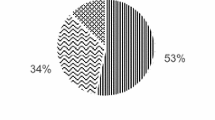Abstract
The purpose of this study was to evaluate the efficacy and safety of the mini-nuc technique for the removal of brunescent and black cataracts. A prospective study was carried out in 33 eyes of 33 patients with cataract nigra operated with the mini-nuc technique between April 2002 and June 2003. Slit-lamp examinations, intraocular pressure (IOP) measurements, and best-corrected visual acuity (BCVA) were assessed pre- and postoperatively. Accompanying systemic diseases were noted. Intraoperative and postoperative complications were evaluated. Unilateral eyes of 33 patients (18 male [54.5%], 15 female [45.5%]) aged between 65 and 90 years (mean 72 years) were operated with the mini-nuc technique. Preoperative BCVA values varied between light perception and 0.2 in the Snellen chart. Intraocular lenses (IOL) were implanted into all of the patients (27 in-the-bag [81.8%], four to sulcus [12.1%], and two with scleral fixation [6.1%]). During the surgery, five patients (15.15%) had zonular dialysis and two (6.1%) had posterior capsule rupture and vitreous loss. Postoperatively, three (9.1%) rises in IOP, two (6.1%) hyphema, and one (3%) IOL subluxation were observed. At the first day visit, the mean of the uncorrected visual acuities (UCVA) was 0.5 in the Snellen chart. At the third month visit, the mean BCVA was observed to be 0.8. The residual mean astigmatism was 0.75 D against the rule. The mini-nuc technique was effective in removing brunescent and black cataracts with a low rate of serious complications. The mini-nuc technique, which is also performed with a small incision and without sutures, might be an alternative to phacoemulsification in cases of cataract nigra.




Similar content being viewed by others
References
Congdon N, Vingerling JR, Klein BE, West S, Friedman DS, Kempen J, O’Colmain B, Wu SY, Taylor HR; Eye Diseases Prevalence Research Group (2004) Prevalence of cataract and pseudophakia/aphakia among adults in the United States. Arch Ophthalmol 122:487–494
Negrel AD, Minassian DC, Sayek F (1996) Blindness and low vision in southeast Turkey. Ophthalmic Epidemiol 3(3):127–134. doi:10.3109/09286589609080118
Beebe DC (2003) The lens. In: Kaufman PL, Alm A (ed) Adler’s physiology of the eye, 10th edn. Mosby, St. Louis, pp 117–160
Mehta KR, Mehta CK (2000) Surgery for brunescent and black cataracts. In: Buratto L, Osher RH, Masket S (eds) Cataract surgery in complicated cases, vol 5. Slack, Thorofare, NJ, p 44
Shepherd JR (1990) In situ fracture. J Cataract Refract Surg 16:436–440
Koch PS, Katzen LE (1994) Stop and chop phacoemulsification. J Cataract Refract Surg 20:566–570
Blumenthal M, Ashkenazi I, Assia E, Cahane M (1992) Small-incision manual extracapsular cataract extraction using selective hydrodissection. Ophthalmic Surg 23(10):699–701
Polat A (2001) Mini-nük’e nasıl başlayalım: convertible mini-nük tekniği. T Klin Oftalmoloji 10:175–177
Polat A (2001) Convertible mini-nuc technique. J Cataract Refract Surg 27:491–492. doi:10.1016/S0886-3350(01)00830-6 (letter)
Blumenthal M (1994) Manual ECCE, the present state of the art. Klin Monatsbl Augenheilkd 205(5):266–270
Blumenthal M, Ashkenazi I, Fogel R, Assia EI (1993) The gliding nucleus. J Cataract Refract Surg 19(3):435–437
Singh R, Vasavada AR, Janaswamy G (2001) Phacoemulsification of brunescent and black cataracts. J Cataract Refract Surg 27:1762–1769. doi:10.1016/S0886-3350(01)00839-2
Tsuneoka H, Shiba T, Takahashi Y (2002) Ultrasonic phacoemulsification using a 1.4 mm incision: clinical results. J Cataract Refract Surg 28:81–86. doi:10.1016/S0886-3350(01)01235-4
Chadha V, Ghosh B, Lall A (2005) Mini-nuc technique. J Cataract Refract Surg 31:2246. doi:10.1016/j.jcrs.2005.01.036
Bourne RRA, Minassian DC, Dart JKG, Rosen P, Kaushal S, Wingate N (2004) Effect of cataract surgery on the corneal endothelium: modern phacoemulsification compared with extracapsular cataract surgery. Ophthalmology 111:679–685. doi:10.1016/j.ophtha.2003.07.015
Boyd BF (1993) Surgical principles and techniques for the small incision, no stitch, mini-nucleus, no phaco, extracapsular cataract extraction. Highlights Ophthalmol 21(5):35–42 (mini highlights)
Smith GT, Liu CSC (2001) Is it time for a new attitude to “simultaneous” bilateral cataract surgery. Br J Ophthalmol 85:1489–1496. doi:10.1136/bjo.85.12.1489
Payne JW, Kameen AJ, Jensen AD, Christy NE (1985) Expulsive hemorrhage: its incidence in cataract surgery and a report of four bilateral cases. Trans Am Ophthalmol Soc 83:181–204
Blumenthal M, Grinbaum A, Assia EI (1997) Preventing expulsive hemorrhage using an anterior chamber maintainer to eliminate hypotony. J Cataract Refract Surg 23:476–479
Ng DT, Rowe NA, Francis IC, Kappagoda MB, Haylen MJ, Schumacher RS, Alexander SL, Boytell KA, Lee BB (1998) Intraoperative complications of 1000 phacoemulsification procedures: a prospective study. J Cataract Refract Surg 24:1390–1395
Prasad S (1998) Phacoemulsification learning curve: experience of two junior trainee ophthalmologists. J Cataract Refract Surg 24:73–77
Yılmaz SO, Yalçın E, Cinhüseyinoğlu N, Arslan MO (2000) Mini-nükleus tekniği ile yapılan PEKKE GİL uygulamalarında intraoperatif komplikasyonlar. MN Oftalmoloji 4:341–343
Gonglore B, Smith R (1998) Extracapsular cataract extraction to phacoemulsification: why and how? Eye 12:976–982
Keskinbora KH (2004) Mini-nuc technique in phacoemulsification. J Cataract Refract Surg 30:2454. doi:10.1016/j.jcrs.2004.08.042 (letter)
Acknowledgments
The authors did not have any financial or proprietary interests during the conduct of the study. The authors did not have any public or private support during the conduct of the study.
The authors have no proprietary or financial interest in the products, methods, or materials presented in this study.
Author information
Authors and Affiliations
Corresponding author
Rights and permissions
About this article
Cite this article
Yuzbasioglu, E., Helvacioglu, F., Tugcu, B. et al. The results of cataract nigra cases operated with the mini-nuc technique. Int Ophthalmol 29, 451–457 (2009). https://doi.org/10.1007/s10792-008-9265-8
Received:
Accepted:
Published:
Issue Date:
DOI: https://doi.org/10.1007/s10792-008-9265-8




